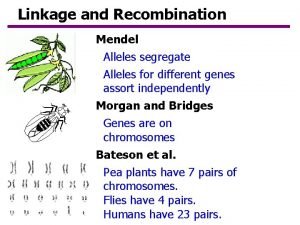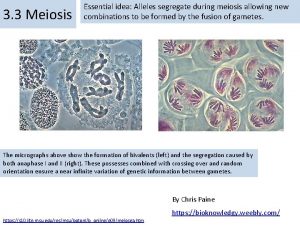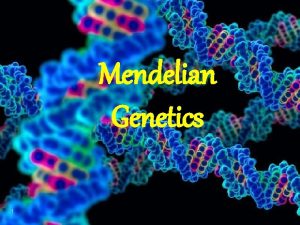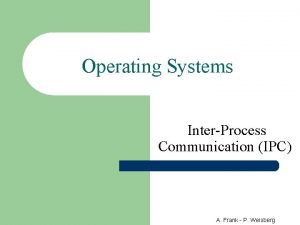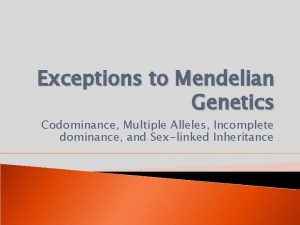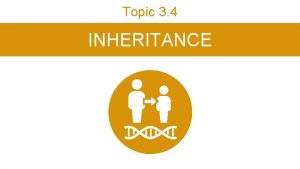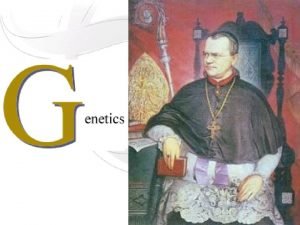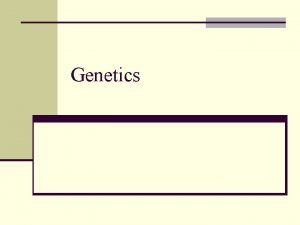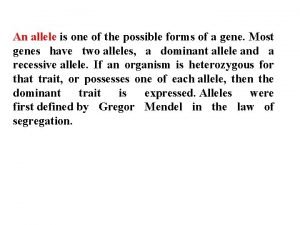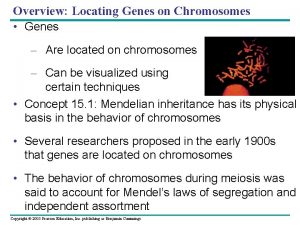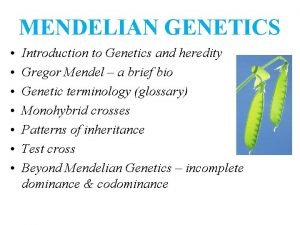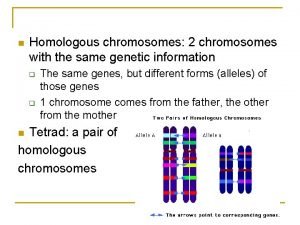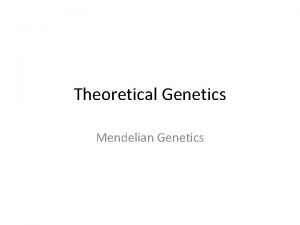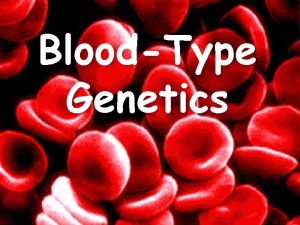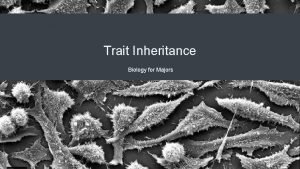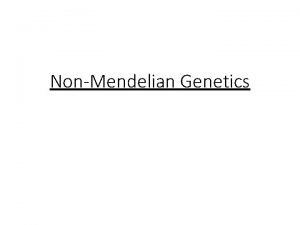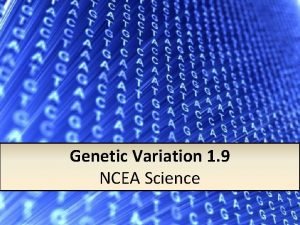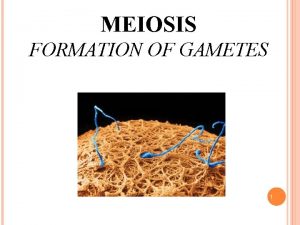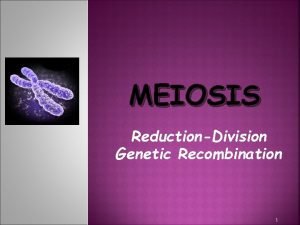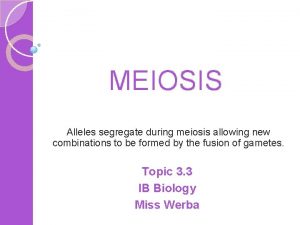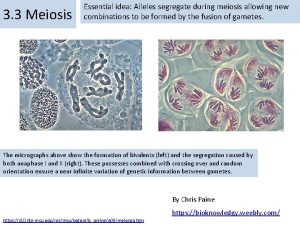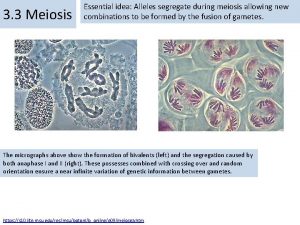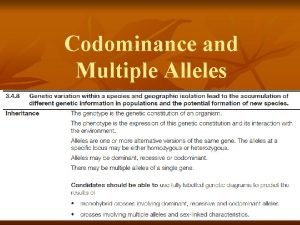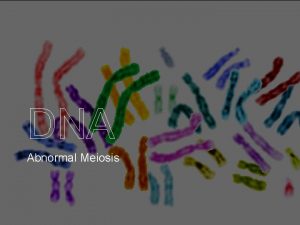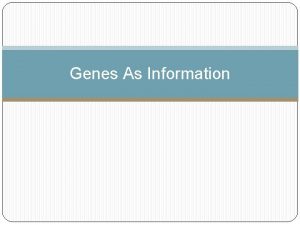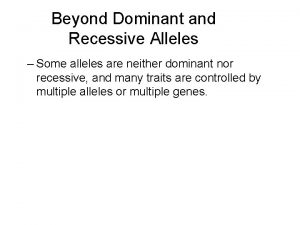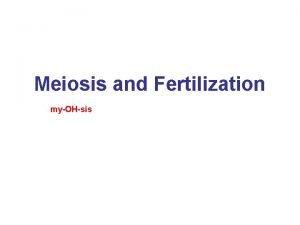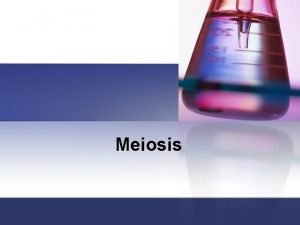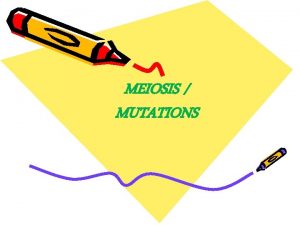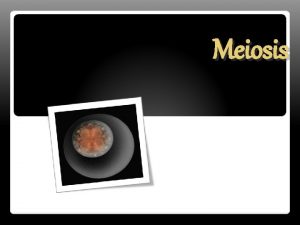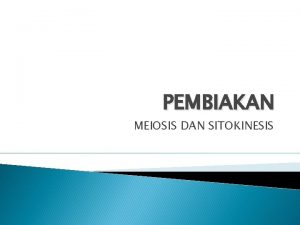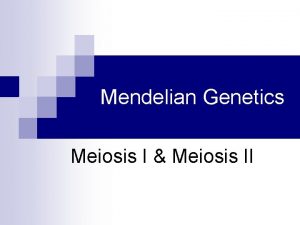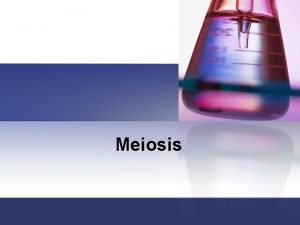3 3 MEIOSIS Alleles segregate during meiosis allowing


























- Slides: 26

3. 3 MEIOSIS Alleles segregate during meiosis allowing new combinations to be formed by the fusion of gametes.

Understandings: ■ One diploid nucleus divides by meiosis to produce four haploid nuclei. ■ The halving of the chromosome number allows a sexual life cycle with fusion of gametes. ■ DNA is replicated before meiosis so that all chromosomes consist of two sister chromatids. ■ The early stages of meiosis involve pairing of homologous chromosomes and crossing over followed by condensation. ■ Orientation of pairs of homologous chromosomes prior to separation is random. ■ Separation of pairs of homologous chromosomes in the first division of meiosis halves the chromosomes number. ■ Crossing over and random orientation promotes genetic variation. ■ Fusion of gametes from different parents promotes genetic variation. Applications and skills: ■ Non-disjunction cause down syndrome and other chromosome abnormalities. ■ Studies showing age of parents influence chances of non-disjunction. ■ Description of methods used to obtain cells for karyotype analysis. (chorionic villus sampling and amniocentesis and the associated risks) ■ Drawing diagrams to show the stages of meiosis resulting in the formation of four haploid cells.

Meiotic Division ■ One diploid nucleus divides by meiosis to produce four haploid nuclei. ■ Separation of pairs of homologous chromosomes in the first meiotic division halve the chromosome number. ■ Meiosis is the process by which sex cells (gametes) are made in the reproductive organs. – It involves the reduction division of a diploid germline cell into four genetically distinct haploid nuclei. ■ The process of meiosis consists of two cellular divisions: – The first meiotic division separates pairs of homologous chromosomes to halve the chromosome number (diploid haploid)


Sister Chromatids ■ DNA is replicated before meiosis so that all chromosomes consist of two sister chromatids. ■ Meiosis is preceded by interphase, during which DNA is replicated (S phase) to produce two genetically identical copies. – The two identical DNA molecules are identified as sister chromatids, and are help together by a single centromere. – The sister chromatids are separated during meiosis II, following the separation of homologous chromosomes in meiosis I.


Stages of Meiosis ■ Skill: Drawing diagrams to show the stages of meiosis resulting in the formation of four haploid cells. ■ Meiosis is two divisions, both divisions are the same process as mitosis (PMAT) – Meiosis I: ■ ■ P-I: M-I A-I T-I – Meiosis II: ■ ■ P-I M-I A-I T-I



Crossing Over ■ The early stages of meiosis involve pairing of homologous chromosomes and crossing over followed by condensation. ■ In prophase I, homologous chromosomes undergo a process called crossing over. ■ Crossing over of genetic material between non-sister chromatids can occur, resulting in an exchange of genetic material. ■ New gene combinations are formed.


Random Assortment ■ Orientation of pairs of homologous chromosomes prior to separation is random. ■ During metaphase I, homologous chromosomes line up at the equator. ■ This orientation of pairs of homologous chromosomes is random, as is the subsequent assortment of chromosomes into gametes. ■ The final gamete will differ depending on whether they got the maternal/paternal copy.


Sexual Life Cycle ■ The halving of the chromosome number allows a sexual life cycle with fusion of gametes. ■ Most sexually reproducing organisms are diploid, meaning they have two copies of every chromosome. ■ Fertilization of two haploid gametes (egg + sperm) will result in the formation of a diploid zygote that can grow via mitosis.


Genetic Variation ■ Crossing over and random orientation promotes genetic variation. ■ Fusion of gametes from different parents promotes genetic variation. ■ 3 main sources of genetic variation arise from sexual reproduction: – Crossing over (in prophase I) – Random assortment of chromosomes (in metaphase I) – Random fusion of gametes from different parents.

Crossing over ■ Crossing over involves the exchange of segments of DNA between homologous chromosomes during prophase I. ■ As a consequence of this recombination, all four chromatids are genetically different.

Random Fertilization

Non-Disjunction ■ Non-disjunction cause Down syndrome and other chromosomal abnormalities. ■ Non-disjunction refers to the chromosomes failing to separate correctly, resulting in gametes with one extra or one less.


Chromosomal Abnormalities ■ If a zygote is formed from a gamete that has experienced a non-disjunction event. ■ Conditions that arise from non-disjunction event include: – Patau’s Syndrome (trisomy 13) – Edwards Syndrome (trisomy 18) – Down Syndrome (trisomy 21) – Klinefelter Syndrome (XXY) – Turner’s Syndrome / Fragile X (monosomy X)

Down Syndrome ■ Individuals with Down syndrome have three copies of chromosome 21 (trisomy 21)

Karyotyping ■ Description of methods used to obtain cells for karyotype analysis (chorionic villi sampling and amniocentesis and the associated risks. ■ Karyotyping is the process by which chromosomes are organized and visualized for inspection. – Karyotyping is typically used to determine the gender of an unborn child and test for chromosomal abnormalities. ■ Cells are harvested from the fetus before being chemically induced to undertake cell division

Chorionic Villi Sampling ■ Involves removing a sample of the chorionic villus (placental tissue) via a tube inserted through the cervix.

Aminocentesis ■ Involves the extraction of a small amount of amniotic fluid (contains fetal cells) with a needle.

Guidance ■ Preparation of microscope slides showing meiosis is challenging and permanent slides should be available in case no cells in meiosis are visible in temporary mounts. ■ Drawings of the stages of meiosis do not need to include chiasmata. ■ The process of chiasmata formation need not be explained.
 When do alleles segregate during meiosis
When do alleles segregate during meiosis When do alleles segregate during meiosis
When do alleles segregate during meiosis Heredity terminology
Heredity terminology Examples of ipc systems
Examples of ipc systems Scout and aunt alexandra communicate very poorly
Scout and aunt alexandra communicate very poorly How does beowulf wound grendel
How does beowulf wound grendel Multiple alleles
Multiple alleles Father of genetics
Father of genetics Hemizygous
Hemizygous Chromosomes and alleles
Chromosomes and alleles Multiple alleles genotypes
Multiple alleles genotypes Bill nye genes worksheet answer key
Bill nye genes worksheet answer key Foil method in dihybrid cross
Foil method in dihybrid cross Alleles
Alleles Where are alleles located
Where are alleles located Test cross
Test cross Homologous pair
Homologous pair Blood type codominance
Blood type codominance Genotypic ratio of monohybrid cross
Genotypic ratio of monohybrid cross Blood type gametes
Blood type gametes Blood type alleles
Blood type alleles Fork line method for trihybrid cross
Fork line method for trihybrid cross Dominant
Dominant Chromosomes with alleles
Chromosomes with alleles 3 facts about meiosis
3 facts about meiosis Codominant alleles
Codominant alleles Homologous and non homologous chromosome
Homologous and non homologous chromosome
